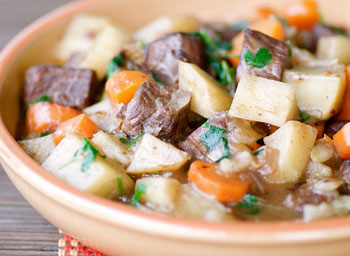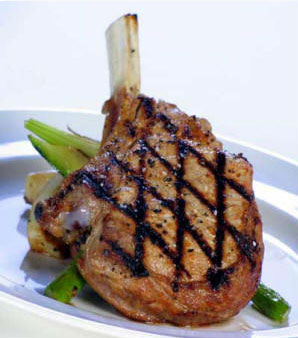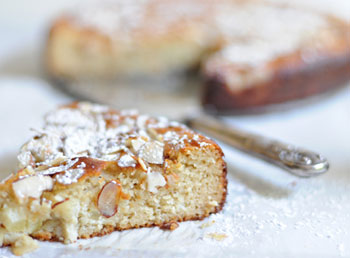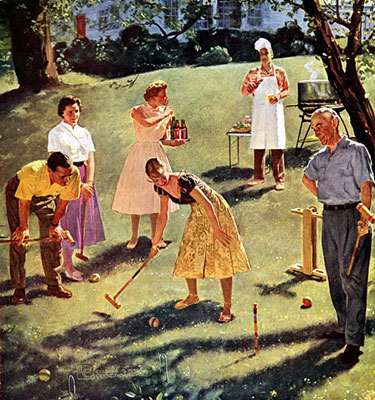 One day when I was a little girl watching my mom make dinner, I asked her why we weren't a "meat and potatoes" family. She said, "That's because we're Italian, and we eat good food."
One day when I was a little girl watching my mom make dinner, I asked her why we weren't a "meat and potatoes" family. She said, "That's because we're Italian, and we eat good food."
I remember thinking, was meat and potatoes bad food? Would it make you sick? I suddenly felt sorry for all those kids at school whose moms cooked meat and potatoes. I secretly wished I could bring them home for dinner so they could have good food like my mom's eggplant parmigiana, escarole and beans, and macaroni with gravy and meatballs.
Other than the once-a-year New England boiled pot roast with potatoes and carrots, my mom never made meat and potatoes meals, and I don't either. The closest I get to making meat and potatoes is a burger and fries, which suits Jeff just fine since his mother also never made meat and potatoes.
Retro Recipes and Traditional Fare
Retro Recipes and Traditional Fare
Veal Chops, How I Love Thee
 There is food that sustains us and then there are foods that make us happy, content and "primally" nourished. I don't eat food that has any labels or tags to read. I just eat the raw ingredient that has a little story to tell me quietly about how I should best cook it.
There is food that sustains us and then there are foods that make us happy, content and "primally" nourished. I don't eat food that has any labels or tags to read. I just eat the raw ingredient that has a little story to tell me quietly about how I should best cook it.
Whether it be vegetable or fish or meat or grain looking at it inspires me to figure out how best to prepare it in this moment. Recipes are only a guideline. It is the cook's choice to have a little fun or a burst of creativity and I guess that depends on the ingredients in front of you and how deeply you react to them.
I have to admit I am a veal chop junkie and I am verbalizing it to the world! I LOVE VEAL CHOPS, HOPELESSLY!!! Whenever I say that, which is rarely I look around like I was talking about George W. Bush because everyone has a reaction to veal and I am sure that it isn't fifty fifty.
Split Pea Soup
 The day after Easter I always find myself with a huge pot of leftover ham stock. In my family we traditionally eat boiled ham and eggs for the holiday. It's a very simple meal that I look forward to every year. I love hard-boiled eggs, so Easter has always been a favorite time of year, because I get to eat all the foods I love, including chocolate. But what to do with all the leftover ham stock? My mom typically makes ham and bean soup, but in the past few years I've started my own tradition of making ham and split pea soup.
The day after Easter I always find myself with a huge pot of leftover ham stock. In my family we traditionally eat boiled ham and eggs for the holiday. It's a very simple meal that I look forward to every year. I love hard-boiled eggs, so Easter has always been a favorite time of year, because I get to eat all the foods I love, including chocolate. But what to do with all the leftover ham stock? My mom typically makes ham and bean soup, but in the past few years I've started my own tradition of making ham and split pea soup.
Since we're already enjoying spring with the suddenly warm weather, it might seem out of place to be making soup. But actually this in-between brisk weather has me craving a soup like this. Fresh peas will be in season soon, but until then split peas are a wonderful substitute. The ham stock is immensely flavorful and works well in this soup. You could also use chicken or vegetable stock. If you have leftover ham, cube it and add it to the soup near the end of cooking time.
Enjoy this Easter leftover soup!
Beignet Bowties
 As a kid, I always wondered why we never celebrated Halloween. Only as an adult did I come to realize that it's really just an American holiday. So, I thought to myself, when do Hungarian kids get a chance to dress up and be whomever they wish to be for one day? The answer is Carnival. I never got dressed up for the holiday, but in Hungary my little nephews always did for school. But never mind all those Mardi Gras celebrations, for me, the best part about Carnival are the doughnuts. Crispy, fluffy, and airy doughnuts!
As a kid, I always wondered why we never celebrated Halloween. Only as an adult did I come to realize that it's really just an American holiday. So, I thought to myself, when do Hungarian kids get a chance to dress up and be whomever they wish to be for one day? The answer is Carnival. I never got dressed up for the holiday, but in Hungary my little nephews always did for school. But never mind all those Mardi Gras celebrations, for me, the best part about Carnival are the doughnuts. Crispy, fluffy, and airy doughnuts!
A few years ago I had a quest to find the best beignets in New York City. I tried the dessert at countless restaurants only to discover leaden balls and soggy balls. I thought I'd never find the airy beignets I had been desperately seeking. That was until a lunch at The Modern. Run by Alsatian chef Gabriel Kreuther in the Museum of Modern Art, the restaurant has some of the best food in the city. The beignets I had for dessert were the crispiest and fluffiest doughnuts on earth. Ever since then I've been wanting to make beignets at home. So for Mardi Gras this year I took the opportunity to do just that.
Simple Almond Lemon Honey Cake
 Slowly, we are all starting to lead a gluten free life. Finding snacks and savories, without gluten is a conscious effort. And, it’s really not that hard. Gluten free pretzels dipped in homemade nutella is one of Levi’s favorites and cut up fruit is now always on the table. I am fortunate to live in sunny California where my local farmer’s markets are filled with ripe melons, crispy apples, and everything else that is in season.
Slowly, we are all starting to lead a gluten free life. Finding snacks and savories, without gluten is a conscious effort. And, it’s really not that hard. Gluten free pretzels dipped in homemade nutella is one of Levi’s favorites and cut up fruit is now always on the table. I am fortunate to live in sunny California where my local farmer’s markets are filled with ripe melons, crispy apples, and everything else that is in season.
With unexpected guests joining us for dinner, I needed a quick dessert. And using stuff in my pantry and fridge was my only option. A while back, I had bookmarked Anja’s recipe for her Apple Lemon Honey Cake. I had apples, I had lemons, and I had a brand new jar of raw honey. Perfect. Best of all, I didn’t have to drag out my Kitchen Aid Mixer to make it. Even more perfect!
This cake feels dense but it isn’t. Is light, not too sweet, and delicious all on it’s own or with a scoop of ice cream on the side.
More Articles ...
Welcome to the new One for the Table ...
Our Home Page will be different each time you arrive.
We're sure you'll find something to pique your interest...


